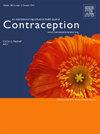妊娠中期扩张期和排空后选择胎儿病理检查的相关因素
IF 2.3
2区 医学
Q1 OBSTETRICS & GYNECOLOGY
引用次数: 0
摘要
目的从2023年起,我院开始实施选择性胎儿病理检查,以最大限度地降低在电子病历系统中转移流产相关信息的风险。我们的目的是描述在扩张和排出后选择胎儿检查的患者比例,并报告意外病理发现的患病率。方法:本研究是一项单机构回顾性图表回顾,回顾了在改为选择性胎儿病理检查之前和之后一年接受医院扩张和疏散的患者。纳入标准为年龄≥18岁,胎龄在14+0 ~ 25+6周之间,并有病理检查记录。我们评估了选择检查的患者比例,以及与人口统计学和手术原因的关联。结果入选前78例,入选检查期130例。各群体的人口统计学特征相似。少数患者在选择期选择胎儿病理检查(28.5%为全面检查,7.7%为有限检查)。选择参加检查的比率各不相同:9.7%(意外怀孕)、31.8%(孕产妇健康指征)、32.1%(胎儿异常)和78.1%(宫内胎儿死亡)。很少有意想不到的潜在重要病理发现,最常见的是脐带过卷或过卷。结论少数患者选择宫内扩张引流后进行胎儿病理检查。在许多情况下,无意中透露堕胎信息的风险可能超过强制检查的好处,几乎没有潜在的重大发现。这些发现告知患者咨询时,同意扩张和疏散。对于那些从检查中受益的患者,需要继续倡导增加对胎儿病理报告的保护。本文章由计算机程序翻译,如有差异,请以英文原文为准。
FACTORS ASSOCIATED WITH CHOOSING FETAL PATHOLOGY EXAMS AFTER SECOND-TRIMESTER DILATION AND EVACUATION
Objectives
In 2023, our hospital transitioned to opt-in fetal pathology examinations to minimize risk of transferring abortion-related information across electronic medical record systems. Our objectives were to describe the proportion of patients opting for fetal examination after dilation and evacuation and report the prevalence of unexpected pathology findings.
Methods
This was a single-institution retrospective chart review of patients who underwent hospital dilation and evacuation for one year before and after changing to opt-in fetal pathology examinations. Inclusion criteria included age ≥18 years, gestational age between 14+0 and 25+6 weeks, and documented pathology exam decision. We assessed the proportion of patients opting for examinations, and associations with demographics and reason for procedure.
Results
We included 78 patients in the before opt-in period and 130 during the opt-in examination period. Demographic characteristics were similar across groups. A minority of patients chose fetal pathology examination during the opt-in period (28.5% full examination, 7.7% limited examination). Rates of opt-in examination varied: 9.7% (undesired pregnancy), 31.8% (maternal health indication), 32.1% (fetal anomaly), and 78.1% (intrauterine fetal demise). There were few unexpected potentially significant pathology findings, most frequently hypocoiled or hypercoiled umbilical cord.
Conclusions
A minority of patients opted for fetal pathology examination after dilation and evacuation. In many cases, the risk of inadvertent abortion disclosure may outweigh the benefit of mandatory examinations, with few potentially significant findings. These findings inform patient counseling at the time of consent for dilation and evacuation. Continued advocacy is needed to increase protections for fetal pathology reports for those patients who benefit from having an examination.
求助全文
通过发布文献求助,成功后即可免费获取论文全文。
去求助
来源期刊

Contraception
医学-妇产科学
CiteScore
4.70
自引率
17.20%
发文量
211
审稿时长
69 days
期刊介绍:
Contraception has an open access mirror journal Contraception: X, sharing the same aims and scope, editorial team, submission system and rigorous peer review.
The journal Contraception wishes to advance reproductive health through the rapid publication of the best and most interesting new scholarship regarding contraception and related fields such as abortion. The journal welcomes manuscripts from investigators working in the laboratory, clinical and social sciences, as well as public health and health professions education.
 求助内容:
求助内容: 应助结果提醒方式:
应助结果提醒方式:


